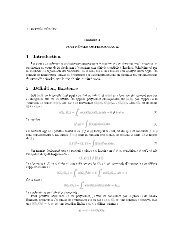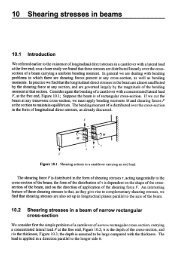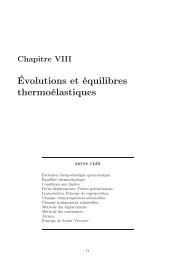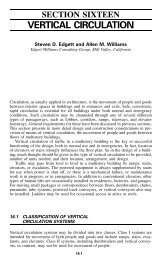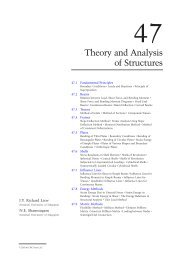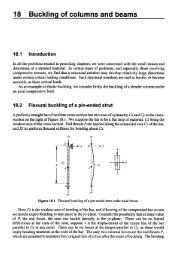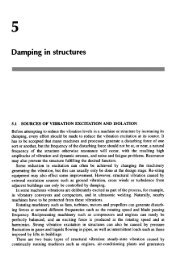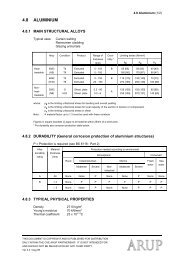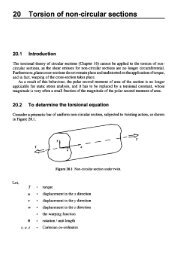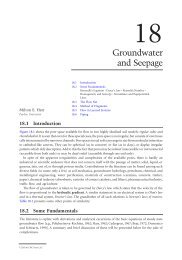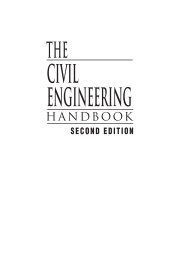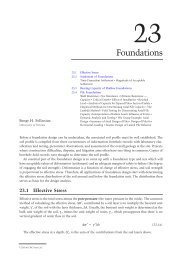Chapter 32 - Deep Foundations - Index of - Free
Chapter 32 - Deep Foundations - Index of - Free
Chapter 32 - Deep Foundations - Index of - Free
- No tags were found...
Create successful ePaper yourself
Turn your PDF publications into a flip-book with our unique Google optimized e-Paper software.
whereC p= empirical coefficient depending on soil type and method <strong>of</strong> construction, see Table <strong>32</strong>.11.D = pile diameterq o= ultimate end bearing capacityand settlement <strong>of</strong> the pile tip caused by load transmitted along the pile shaft iswhereCs= ( 093 . + 016 . D/ B)Ch = embedded lengthpSCQs s=hqTABLE <strong>32</strong>.11 Typical Values <strong>of</strong> C pforEstimating Settlement <strong>of</strong> a Single PilesSoil Type Driven Piles Bored PilesSand (dense to loose) 0.02–0.04 0.09–0.18Clay (stiff to s<strong>of</strong>t) 0.02–0.03 0.03–0.06Silt (dense to loose) 0.03–0.05 0.09–0.12Note: Bearing stratum under pile tip assumed toextend at least 10 pile diameters below tip and soilbelow tip is <strong>of</strong> comparable or higher stiffness.o(<strong>32</strong>.26)Method Using Localized Springs: The t–z and Q–z methodIn this method, the reaction <strong>of</strong> soil surrounding the pile is modeled as localized springs: a series <strong>of</strong>springs along the shaft (the t–z curves) and the spring attached to the tip or bottom <strong>of</strong> a pile (theQ–z curve). t is the load transfer or unit friction force along the shaft, Q is the tip resistance <strong>of</strong> thepile, and z is the settlement <strong>of</strong> soil at the location <strong>of</strong> a spring. The pile itself is also represented asa series <strong>of</strong> springs for each segment. A mechanical model is shown on Figure <strong>32</strong>.5. The procedureto obtain the settlement <strong>of</strong> a pile is as follows:• Assume a pile tip movement zb_1; obtain a corresponding tip resistance Q_1 from the Q–z curve.• Divide the pile into number <strong>of</strong> segments, and start calculation from the bottom segment.Iterations:1. Assume an averaged movement <strong>of</strong> the segment zs_1; obtain the averaged side frictionalong the bottom segment ts_1 by using the t–z curve at that location.2. Calculate the movement at middle <strong>of</strong> the segment from elastic shortening <strong>of</strong> the pile underaxial loading zs_2. The axial load is the tip resistance Q_1 plus the added side friction ts_1.3. Iteration should continue until the difference between zs_1 and zs_2 is within an acceptabletolerance.Iteration continues for all the segments from bottom to top <strong>of</strong> the pile.• A settlement at top <strong>of</strong> pile zt_1 corresponding to a top axial load Qt_1 is established.• Select another pile tip movement zb_2 and calculate zt_2 and Qt_2 until a relationship curve<strong>of</strong> load vs. pile top settlement is found.The t–z and Q–z curves are established from test data by many authors. Figure <strong>32</strong>.6 shows the t–zand Q–z curves for cohesive soil and cohesionless soil by Reese and O’Neil [57].Although the method <strong>of</strong> t–z and Q–z curves employs localized springs, the calculated settlementsare usually within a reasonable range since the curves are backfitted directly from the test results.Factors <strong>of</strong> nonlinear behavior <strong>of</strong> soil, complicated stress conditions around the pile, and partial© 2000 by CRC Press LLC



